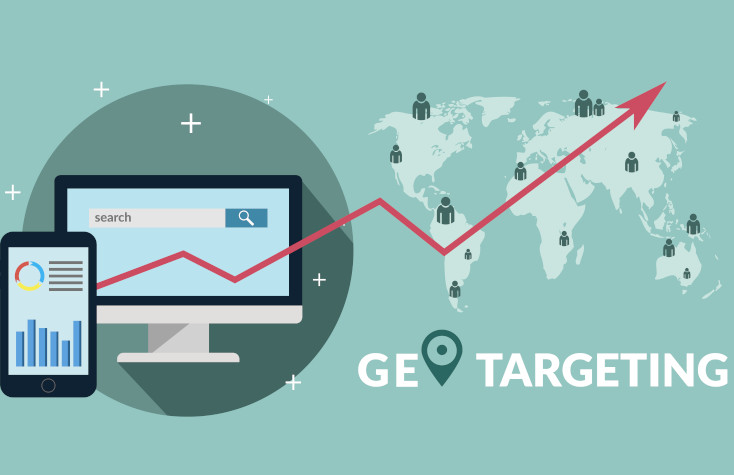Paid Geomarketing – Geotargeting with Social & Google Ads
What if your ads could appear to the right people at the right time? They can, and it’s all thanks to geotargeting. Whether used on social media or Google Ads, this marvelous marketing tool can bring about the conversions and growth you need with an outstanding (and unforeseen) return on investment. Intrigued yet? Then let’s continue…

Geotargeting is an essential part of any digital geomarketing strategy. In our current decade, with the rapid growth of mobile users, it would be nearly impossible to plan an effective online strategy without involving a geotargeting strategy for your ads.
But what are geomarketing and geotargeting? Geomarketing involves implementing geographical intelligence into marketing strategies. Paid geotargeting (also called local PPC), is a powerful way for advertisers to accurately specify the locations in which they want their ads to be shown.
Location-based geotargeting is an efficient tool for focusing your ads on a specific market within a particular location – this results in better and more relevant messaging that also brings a higher return on investment.
Advertising to local prospects is one of the preferred methods used in paid search campaigns because relevant content and messaging go precisely to those interested in a company’s products or services in a particular location. It can also be done on multiple channels.
Geotargeting on Social Media
Geotargeting can be done on all popular social media platforms: Facebook, Instagram, Twitter, LinkedIn, and others. Also, it relies highly on mobile devices, making it a perfect fit for social media.
Over the last two years, 43% of users between the ages of 16 and 64 have started to spend more time on social media. (source Smart Insights, 2022)
Specificity can be enhanced further by targeting based on specific demographics, such as age, gender, or interests. This might seem complicated and technical, but social media platforms are built to be user-friendly and allow you to navigate through their functions quite easily.
Facebook and Instagram posts and pages, tweets and accounts, and LinkedIn posts or articles can all be promoted through specific geotargeting. Adapting and scheduling your social media content can prove to have a dramatic effect on your brand awareness and conversions when combined with a robust geotargeting strategy.
Google Ads Geotargeting
With Google Ads, you can target audiences based on country, state, county, Nielsen DMA regions, cities, congressional districts, airports, universities, or any radius you set around specific locations – the sky's the limit. For small local businesses that rely primarily on in-store traffic, proximity, or deliveries, Google Ads is an essential tool in their local PPC campaigns.
Unlike geofencing (another reliable tool for your local marketing efforts), which targets users by their IP address, paid geotargeting works by targeting posts and ads by reaching the target audience by their listed addresses (city/state/country in which they currently reside).
The median cost-per-click in Google Ads search advertising in the United States is $2.61. (source Statista, 2022)
Google Ads allows you to exclude locations and adjust your bids according to the areas that yield that maximum performance. Besides the enhanced targeting effect, geotargeting with Google Ads also gives you more leverage over your data and allows you to fine-tune your ads to increase user engagement.
Let’s say you have a car dealership located in Camden, Maine; you can choose to target a larger area. Maybe you also want to include Rockport because it’s nearby or only focuses specifically on the city, depending on your campaign. It wouldn’t be wise to target the whole New England area and, of course, there are a lot of other car dealerships out there – in this case, you want to be as specific as you can be to maximize your results.
Optimize for Success
To harness the power of geotargeted ads, you need to optimize them accordingly. When starting a geotargeting campaign, you’ll need to ensure that you are targeting the locations in which your customers are based. Targeting users outside your business’s relevant area will only waste impressions and clicks.
You can use Google Trends to find out which areas are most likely to be interested in your company’s products or services. Google Trends provides precious insights into what keywords your customers are typing by country, state, and city. It’s advised to include regional terms in your keyword list, even though geotargeting will list the broad terms to be seen only in the local searches in which you want them to appear.
Make sure to include the name of your targeted area/location somewhere in the geotargeted ad (ideally in the title). When your ad’s text corresponds to a user’s search query, it will appear in bold lettering on the search engine result page (SERP), helping it stand out.
Whether you run an online, offline, or hybrid business, geotargeting is a highly effective marketing tool that brings unforeseen positive results when used correctly. Ultimately, it provides the necessary insights to build ads that drive more revenue and increase conversions.